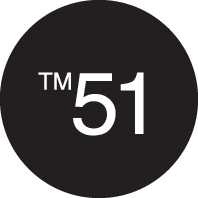Drift
Frode Markhus
Exhibition period
Galleri TM51 19.09.14 – 12.10.14
Galleri TM51 Infill 04.09.14 – 12.10.14
TM51 Window Gallery 04.09.14 – 01.11.14
His washed out face is seen from the side to better show off his thinning mane, slicked back to give the impression of a virile volume. Like his facial features his right arm too is almost entirely erased, only a blurry patch of watered down brown tones. Pushed all the way into the back of the studio space, which this particular painting (Secretary) opens onto, this ghostly rendition of the artist seems busy disappearing. The proportions of the secretary on the other hand – conspicuously foregrounding the scene with her wild red coiffure blocking our view of the canvas that the artist behind her is busy contemplating – belong to a different regime of visibility. She has no issue with taking centre stage, posing confidently with one hand resting on her hip. Her red lips dart daringly from the canvas, her facial features are so exaggerated they look caricatured even for a caricature. Frode Markhus's paintings are always busy caricaturing. Executed with childish bravado – though of a kind compulsively visited by painful self-awareness and self-mockery – they ask the question of how to shore up the inhibiting realisation that the happy act of painting has become all but replaced with its own administration. Administration is all the disciplining worries that's lugged along to the studio and that shifts attention away from the canvas, onto social and professional concerns.
It's incumbent on painting, then, to somehow regain its lost capacity for dumbness (as in numbness to extra-painterly demands) if it is to be habitable as a practice of a specific kind. But to dumb down painting you need dumb subjects. And in the attempt you discover that what is lost perhaps is not so much the messy studio, the twisted tubes and discarded brushes with their paint-caked hairs sticking out every which way, that you have to shuffle through and kick aside to reach the canvas, but the access to a subject that asks to be dealt with in the particular frame of mind induced by these working conditions. Markhus's task then would be to reconstruct a painting-subject that is equal to the act, that somehow mirror back the naive industry of painting suggested here.
The large paintings Markhus presents at TM51 are made with watercolour and oil-pastels. Even if flat, no thick smears that protrude from the surface, his pictures still exhibit a strikingly haptic surface, an effect produced by the aggressive application of haggard pastel-hatching. When applied on selected volumes the technique effectively suck these shapes to the foreground regardless of where they appear to belong within the picture's spacial order. The gesture is ambivalent: It both sharpens and emphasises certain forms, cutting them loose from the landscape by giving them a hard contour and a sort of rough immediacy, but also overwrites them with a coat of incessant mark-making that is as much a trace of the artist's hand as it is a means to depict. To Markhus, bringing images to life is, it seems, a self-defeating act. The very gesture the figure rely on to surface, the drawing or painting utensil crisscrossing the canvas, also keeps the motif from crossing the threshold between materiality and depiction. Markhus's heavy-handedness helplessly pushes the rock, tree or human figure he is developing back towards non-specificity and materiality. This clumsy double-gesture is emblematic of Markhus's painter, who develops and destroys form in one simultaneous gesture.
The large canvases are accompanied by several smaller works on paper where the subject reside closer to non-figuration. But the attempt for some kind of transcendence can never be allowed to entirely slip away (letters! cocks!). It would risk the image drifting too far towards what it dreads: restrained, administered abstraction.
Painting in Markhus's case not only depicts nature – or attempts to – but have come to be nature. What was once a technology that man could use to wring from nature its own image is threatening to become as uninhabitable as the very woods it tries to model. The painter's inability to conjure the landscape finds an equivalent in the lone figures that often populate Markhus's canvases and their hapless endeavour to master the outdoors. Their vulgar cartoon-features and blobs-for-hands speak to a lack of sophistication and mastery. Nature is composed as a vortex that bends in on them, either to swallow and erase them or because their inane activity is what conjures this landscape in the first place, as a sort of ectoplasm. Like the frantic paddler in The Adventurist (Fjord) who is threatened on all sides by a hostile sea and looming stacks of rock that seem to upturn any spacial coherence, all but ready to collapse on him, Markhus's painter work under correspondingly precarious conditions, desperately trying to keep the walls of his world from toppling down while pretending leisure.
Written by Stian Gabrielsen


